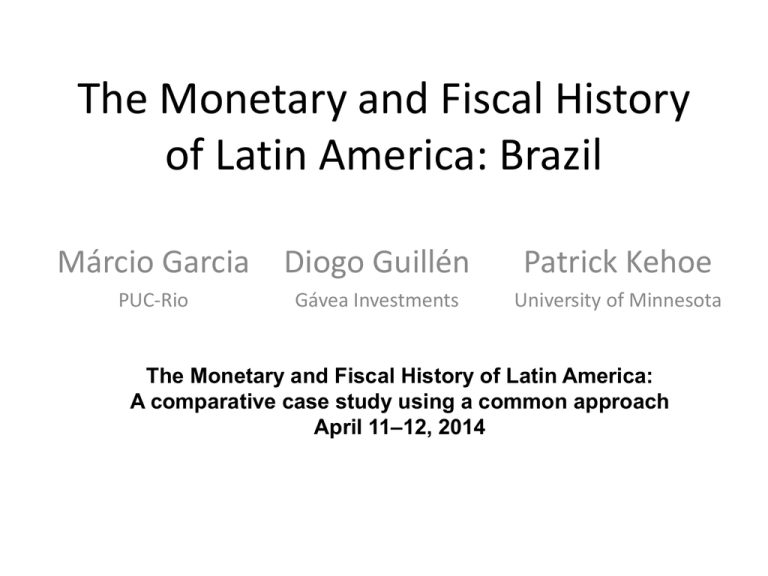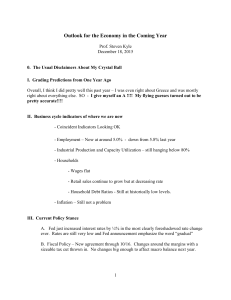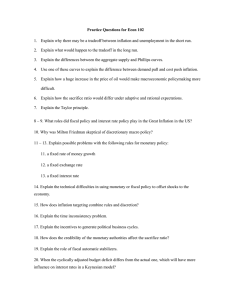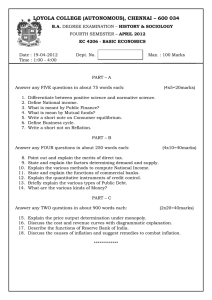The Monetary and Fiscal History of Latin America: Brazil Márcio Garcia Diogo Guillén
advertisement

The Monetary and Fiscal History of Latin America: Brazil Márcio Garcia Diogo Guillén PUC-Rio Gávea Investments Patrick Kehoe University of Minnesota The Monetary and Fiscal History of Latin America: A comparative case study using a common approach April 11–12, 2014 INTRODUCTION Brazilian Hyperinflation: Protracted and Resilient • Lasted a decade • Why? Indexation made hyperinflation possible without output collapse; • 5 failed attempts to stabilize; • The last attempt worked: Real Plan (July, 1994); • Inflation has been controlled for the last 2 decades; • Money and inflation: annual inflation rates are well explained by static link with annual money growth. Not Classic Sargent-Wallace Fiscal Dominant Stabilization • Standard fiscal-driven-stabilization logic assumes that money • • • • • • • printing ends when a large credible fiscal adjustment is made; Brazilian Real was not like that; Money hyper-printing stopped in the Real Plan But fiscal situation deteriorated markedly under this plan Saw higher operational deficits (primary+real interest on debt) Only five years after stabilization did fiscal stance improve; Punchline: While fiscal stance eventually improved, there was no “deliberate and drastic” fiscal measures associated with the end of the Brazilian hyperinflation. Is Brazil a Pro-Friedman, Anti-Sargent-Wallace case? Brazilian Stabilization: Deindexation and Stop Money Printing • Stabilization displays a close static link between money printing and inflation; • The fiscal deterioration, from 1995 to 1999, somehow did not derail stabilization. Plan of This Talk • • • • • • History of the Brazilian hyperinflation; The 5 failed Stabilization attempts; The Real Plan: Why did it work? Because cut money growth; Didn’t cut deficits; Tight contemporaneous link between money and inflation. BRAZILIAN HYPERINFLATION: HISTORY BRAZIL: PRICE LEVEL (in log) Consumer Price Index (log(Jan, 1985)=1) 10 Real 9 Summer Cruzeiro Collor II 8 Bresser Collor I 7 6 5 4 3 2 1 0 Source: Consumer Price Index (IPCA) from IBGE BRAZIL: PRICE LEVEL (in log) and INFLATION (% per month) 10 90.00 Real 9 80.00 Summer Cruzeiro 8 Bresser Collor II Collor I 70.00 7 60.00 6 50.00 5 40.00 4 30.00 3 20.00 2 10.00 1 0.00 0 -10.00 Source: Consumer Price Index (IPCA) from IBGE Brazilian Hyperinflation • Lasted much longer than classic hyperinflations. Classical Hyperinflations Av Monthly Av Monthly M Inflation Rate (%) Growth (%) Country Beginning End Pt/P0 Austria Oct. 1921 Aug. 1922 70 47 31 Germany Aug. 1922 Nov. 1923 1x1010 322 314 Greece Nov. 1943 Nov. 1944 4.7x106 365 220 Hungary 1 Mar. 1923 Feb. 1924 44 46 33 Hungary 2 Aug. 1945 Jul. 1946 3.8x1027 19800 12200 Poland Jan. 1923 Jan. 1923 699 82 72 Russsia Dec. 1921 Dec. 1921 1.2x105 57 49 Brazil Jan. 1983 Jun. 1994 1.4x1010 20 19 Why Brazilian Hyperinflation Lasted So Long? • Indexation makes possible to cope with hyperinflation; • No collapse of GDP growth. Annual Inflation and GDP Growth 3000.00% 10.00% GDP Growth 8.00% 2500.00% 6.00% 4.00% 2000.00% 2.00% 1500.00% 0.00% Inflation -2.00% 1000.00% -4.00% -6.00% 500.00% -8.00% 0.00% -10.00% Jan-80 Jan-81 Jan-82 Jan-83 Jan-84 Jan-85 Jan-86 Jan-87 Jan-88 Jan-89 Jan-90 Jan-91 Jan-92 Jan-93 Jan-94 Jan-95 • Even during hyperinflation, no collapse of GDP growth Annual Inflation and GDP growth % % 3,000.00 8.00 2,500.00 6.00 2,000.00 4.00 1,500.00 2.00 1,000.00 0.00 500.00 -2.00 0.00 -4.00 Annual Inflation GDP growth Why no collapse GDP growth: Indexation • Started in late 60s; • Idea: isolate real economy from inflation; • Advocated by Milton Friedman; o “2nd best to price stability”; • Mixed blessing: – Easy to live with high inflation, but – Made inflation fight more difficult and politically less desirable. • One of the reasons inflation lasted longer. Why Didn’t Brazil Endogenously Dollarize • In most other hyperinflation, agents gave up holding local currency and used dollars; • Didn’t happen in Brazil because bank deposits were protected against inflation; • To provide those inflation-protected deposits, banks held gov’t bonds that were either indexed to inflation or of very short maturity; • Punchline: Brazil avoid dollarization by engineering a domestic substitute to its hyperinflated currency, i.e., a domestic currency substitute How to Stop Printing Money? • The Brazilian Central Bank could not raise much the real interest rate (passive monetary policy) or many banks would fail; • So, money printing could not stop cold-turkey; • What made possible the end of passive monetary policy was the end of indexation through the transformation of an indexed unit of account pegged to the US dollar (the URV, Real Unit of Value) in the new currency, the Real. Inflation History from 1980 • 1980-85: Crawling towards hyperinflation; • 1985-94: Five failed plans o 1986: Cruzado o 1987: Bresser o 1989: Summer o 1990: Collor I o 1991: Collor II • 1994: A successful plan: Real Plan Jun-95 Collor II Jan-95 Aug-94 Mar-94 Oct-93 May-93 Dec-92 Jul-92 Feb-92 Sep-91 Summer Apr-91 Nov-90 Jun-90 Jan-90 Aug-89 Bresser Mar-89 Oct-88 May-88 80.00% Dec-87 Jul-87 Feb-87 Sep-86 Apr-86 Nov-85 Jun-85 Jan-85 Aug-84 Mar-84 Oct-83 May-83 Dec-82 Jul-82 Feb-82 Sep-81 Apr-81 30.00% Nov-80 Jun-80 Jan-80 Monthly Inflation 90.00% Real Collor I 70.00% Cruzado 60.00% 50.00% 40.00% Monthly Inflation 20.00% 10.00% 0.00% Jan-14 Jan-13 Jan-12 Jan-11 Jan-10 Jan-09 Jan-08 Jan-07 Jan-06 Jan-05 Jan-04 Jan-03 Jan-02 Jan-01 Jan-00 Jan-99 Jan-98 Jan-97 Jan-96 C II Jan-95 Jan-94 Jan-93 Jan-92 CI Jan-91 S Jan-90 BR Jan-89 80.00 Jan-88 CRZ Jan-87 Jan-86 Jan-85 % 90.00 Monthly Inflation REAL 70.00 60.00 50.00 40.00 30.00 20.00 10.00 0.00 THE PREVIOUS 5 FAILED PLANS Five Failed Plans • Many were ambitious … but all failed Five Failed Plans • Many were ambitious … but all failed. • Main weakness: continued printing money Details of the Five Failed Plans Cruzado Plan (1986) • Froze Prices and wages, but: – Wages were raised at the beginning of the plan; – If inflation>20%, wages automatically adjusted; • • • • • • Pegged exchange rate to $; Changed currency (cut 3 zeros); Forced interest rate conversion; Ended Central Bank automatic finance; No effective major change in fiscal policy; In 10 months, back to double-digit monthly inflation. Forced Interest Rate Conversion • Existing contract: example – Suppose cruzeiro interest rate: 14% per month; – Borrowed 1000 cruzeiros just before the plan; – Owed 1,140 cruzeiros in one month. • Under plan: – Forced conversion into cruzado contract; – 0% interest rate in new currency; – Now owe 1 cruzado in a month. End of Central Bank automatic finance • Before the plan: – Commercial government bank (Banco do Brasil) gave subsidized loans to both private agents and the government; – Central Bank printed money to cover subsidies. • Plan: – Forbade this practice. Jul-92 Apr-92 Jan-92 Oct-91 Jul-91 Summer Apr-91 Jan-91 Oct-90 Jul-90 Apr-90 Jan-90 Oct-89 Jul-89 Bresser Apr-89 Jan-89 Oct-88 Jul-88 Apr-88 Jan-88 Oct-87 70.00% Jul-87 Apr-87 Jan-87 Oct-86 Jul-86 60.00% Apr-86 Jan-86 Oct-85 Jul-85 Apr-85 Jan-85 Oct-84 Jul-84 Apr-84 Jan-84 Oct-83 20.00% Jul-83 Apr-83 Jan-83 Monthly Inflation 90.00% Collor II 80.00% Collor I Cruzado 50.00% 40.00% 30.00% Monthly Inflation 10.00% 0.00% Bresser Plan (1987) • Froze prices; • Adjusted wages based on the average of the three previous months; • Raise real interest rates to a positive value; • Fiscal: intended to keep nominal deficit to 3.7%, but actual nominal deficit was 33%. • In 3 months, back to double digit monthly inflation. New Constitution (1988) • Worsened fiscal situation and made harder to adjust labor and spending: – Increased expenditures and transfers from the central government to states and municipalities; – Reduced work week from 48 to 44 hours; – Increased firing costs and overtime compensation; – Earmarked revenues. Summer Plan (1989) • • • • • • New Constitution 1988; Froze prices (designed to last 4 to 8 weeks); New currency: cruzado novo (cut 3 zeros); Fixed exchange rate (1 Cruzado Novo = US$1); De-indexed prices; Ambitious fiscal and monetary reform: – Congress refused. Collor I Plan (1990) • Froze Prices and Wages; • New Currency: Cruzeiro; • Monetary Component: – Suspension of convertibility of 80% of all financial assets for 18 months. • Fiscal Component: – Ambitious fiscal plan: • Privatizations: some succeeded. • Other fiscal reforms: short-lived. Collor II Plan (1991) • • • • Froze Prices; Fixed exchange rate; Opens up the economy; Fiscal: – reduce government expenditures: • firing civil servants (many got reinstated in courts); • closing public services (many reopened); • privatization of state owned enterprises. THE REAL PLAN: WHY DID IT WORK? Why the Real Plan worked • Because stopped printing money; • NOT because of credible fiscal reform; • In fact, fiscal policy got worse during first 5 years of the plan; • Consistent with Friedman; • Not consistent with Sargent Wallace fiscal dominant regime; • Is consistent with SW money dominant regime; • Tight money now means low inflation now. Jan-14 Jan-13 Jan-12 Jan-11 Jan-10 Jan-09 Jan-08 Jan-07 Jan-06 Jan-05 Jan-04 Jan-03 Jan-02 Jan-01 Jan-00 Jan-99 Jan-98 Jan-97 Jan-96 C II Jan-95 Jan-94 Jan-93 Jan-92 CI Jan-91 S Jan-90 BR Jan-89 80.00 Jan-88 CRZ Jan-87 Jan-86 Jan-85 % 90.00 Monthly Inflation REAL 70.00 60.00 50.00 40.00 30.00 20.00 10.00 0.00 TIGHT CONTEMPORANEOUS LINK BETWEEN MONEY AND INFLATION Annual Inflation and Money Growth 3500.00% 3000.00% 2500.00% Inflation 2000.00% 1500.00% Monthly growth of M0 1000.00% 500.00% 0.00% Jan-80 Jan-81 Jan-82 Jan-83 Jan-84 Jan-85 Jan-86 Jan-87 Jan-88 Jan-89 Jan-90 Jan-91 Jan-92 Jan-93 Jan-94 Jan-95 -500.00% • Money growth and inflation graph (annual tracks) Annual Inflation and Money Growth 3000.00% CRZ BR S CI C II REAL 2500.00% 2000.00% 1500.00% 1000.00% 500.00% 0.00% Money Growth Annual Inflation Monthly Inflation and Monthly Growth of M0 (5 month moving average) 90.00% Summer 80.00% Bresser Real Collor II Collor I 70.00% Cruzado 60.00% 50.00% 40.00% Inflation Monthly growth of M0 30.00% 20.00% 10.00% • Money growth and inflation (monthly dances) Jun-95 Jan-95 Aug-94 Mar-94 Oct-93 May-93 Dec-92 Jul-92 Feb-92 Sep-91 Apr-91 Nov-90 Jun-90 Jan-90 Aug-89 Mar-89 Oct-88 May-88 Dec-87 Jul-87 Feb-87 Sep-86 Apr-86 Nov-85 Jun-85 Jan-85 Aug-84 Mar-84 Oct-83 May-83 Dec-82 Jul-82 Feb-82 Sep-81 Apr-81 Nov-80 Jun-80 Jan-80 0.00% Monthly Inflation and Monthly Growth of M0 (5 month moving average) 100.00% 90.00% CRZ BR S CI C II REAL 80.00% 70.00% 60.00% 50.00% 40.00% 30.00% 20.00% 10.00% 0.00% Monthly Growth of M0 Monthly Inflation Fiscal Improvement Pre-Real Fiscal Deterioration Under Real 7.5 CRZ S BR 5.5 CR II REAL CR I 5.1 3.7 3.9 3.9 3.5 1.5 1.3 0.7 0.0 0.5 0.6 0.5 0.4 -0.4 -0.5 -2.5 PSBR - Operational Seigniorage 5yr Average - PSBR Operational 5yr Average - Seigniorage Annual Money Growth and Inflation 3000% CRZ BR S REAL CI C II 2500% 2000% 1500% 1000% 500% 0% Annual M Growth Annual Inflation Public Debt Increased Under Real Plan BRAZIL : PUBLIC NET DEBT (% GDP) 70.00 CRZ B S C1 C2 R 60.00 50.00 40.00 30.00 20.00 10.00 0.00 1981 1982 1983 1984 1985 1986 1987 1988 1989 1990 1991 1992 1993 1994 1995 1996 1997 1998 1999 2000 2001 2002 2003 2004 2005 2006 2007 2008 2009 2010 -10.00 -20.00 Public Foreign Net Debt Public Domestic Net Debt Public Total Net Debt Real Plan • Ingenious mechanism (URV) to get relative prices “right” in the new currency, the real; • Exchange rate ceiling: 1 real = 1 dollar: – Given high interest rates, capital flew in and parity to dollar became credible, serving as a nominal anchor; • Fiscal: – Suspension of part of earmarked transfers to states and municipalities to get fiscal surpluses; – Extra taxes on financial intermediaries; THE URV (became the Real) • Real Unit of Value: 1 URV = 1 US$; • March-June 94: new unit of account with stable purchasing power; • Labeled prices in both URV and cruzeiro real; • Idea: o Paid for goods only in cruzeiro real; o Prices in unit of account URV were stable; o Replaced URV with real on July 1, 1994. Conclusion • In the Brazilian hyperinflation experience, the link between inflation (and, therefore, seignorage) and money growth is contemporaneous; • On the other hand, fiscal improvements in the early 90s did not help on the inflation front, until the 94 Real Plan, while the marked deterioration of the fiscal stance from 95 to 99 did not derail stabilization. • Friedman-like monetary dominant regime fits data better than fiscal dominant regime as in “unpleasant arithmetic” or “end of 4 big inflations”.






